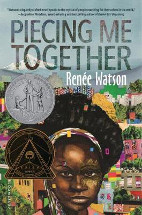Piecing me together by Renee Watson

Bloomsbury, 2017. ISBN 9781681191058
(Age: Young Adult) For Jade, a young black woman living in New York
who attends a school that offers specific help to students,
particularly financial help for those who need it, the final years
of high school are pivotal to her future. She has to travel a long
distance to attend school and because of the straitened
circumstances of her family's life, often has little to eat. Taking
the opportunity to learn Spanish opens her mind to the meaning of
words, and she embraces the opportunity to think about her world in
a new way. We see the chapter headings as pertinent to the novel in
that they reflect Jade's thoughts and her joy in incorporating her
new knowledge into her life e.g. Chapter 10, presentar, to introduce.
To find out who she is and what possibilities exist for her in the
future, she feels driven to seek answers from her everyday
experience. This is limited, as her family struggles to have enough
to eat, she has to travel a long distance by public transport to get
to the school, and her mother needs to work long hours to support
them, desperate to keep Jade in school to enable a better future for
her. Fortunately, the school institutes a program that offers
mentorships by women not too much older than the girls, and this is
the door that offers hope.
We are gradually made aware of her family's poverty, yet, despite
this her mother is determined that their life be one that is
grounded in love and kindness. Watson's intention is to enable us to
recognise immediately that Jade's family is decent, good and
desperately clinging to the hope that Jade will be able to find a
path to a more hopeful future. Her turning point arises when she
decides to speak out about what is wrong with the program,
suggesting that what girls like her need is not just what has been
planned but what she has come to understand needs to be done.
Watson's writing is intensely powerful, without guile, and her
narrator's voice is a call that does not excite agitation or a call
for violent upheaval, structuring characters and plot that
foregrounds the need for a rational and calm approach to the
education of all minorities, one that will enable them to able to
choose and thrive in the world, taking their place fairly and justly
alongside all others.
This challenging book is exciting and uplifting in the hope it
offers, setting a challenge for people who do not realise the level
of poverty in which some people, impoverished by education and
financial background, colour or race, manage to live, in big
third-world cities such as New York.
The narrative fits perfectly into its niche, occurring in the
present, modern world that foregrounds the claim for equality but
too often falls short of this high ideal. It is suitable, and indeed
highly recommended, for adolescents and adult reading, its clarity
of issue never suppressing the wonderfully told narrative that
captivates us to the last page. The characters are deftly drawn and
match their circumstances, and the place, New York City, comes alive
through the vivid construction of place by its writer. It is a
compelling book precisely because it advocates change through ways
that do not frighten people, rather calling for the recognition of
the humanity of all and the need for us all to be equal, in all
ways.
Elizabeth Bondar